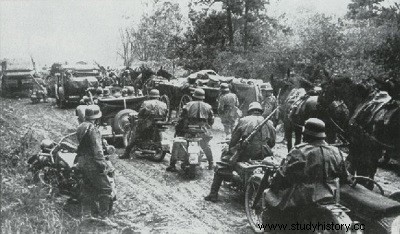
Germany had prepared its aggression carefully and long in advance. It is clear from Hitler's many statements and from his book Mein Kampf that the Führer regarded the Soviet Union as his main enemy and the essential obstacle to his domination of Europe and, subsequently, of the world.
The circumstances of the outbreak of the Second World War caused the German army to strike its first blows against Czechoslovakia, Poland and the countries of Western Europe. But the objectives of the Third Reich remained no less identical and, from July 1940, the high command of the Wehrmacht undertook the development of the invasion plan of the U.S.S.R. In autumn of the same year began the transfer of German troops to the east, to the territory of Poland.
On December 18, 1940, the "Barbaroussa" plan was approved by Hitler.
At that time, the Soviet people were in the midst of peaceful labor. The war had been going on for almost two years in Europe, but the he Soviet Union stood aloof from it and its government's efforts were directed towards avoiding any involvement in military conflict.This was precisely the objective pursued by the Soviet-German non-aggression treaty, concluded on August 23, 1939. on the proposal of Berlin. Both the leaders and the people of the USSR certainly understood that Hitler would not stop halfway and that, sooner or later, he would turn his weapons against our country. Nevertheless, Moscow respected the commitments resulting from the treaty and required its troops stationed along the border to refrain from any action that could be construed as military provocation by the Germans.
The desire to avoid war in no way constituted proof of the weakness of the USSR, but flowed from its socialist nature itself, from the principle of peaceful coexistence on which rested its foreign policy defined by Lenin, founder of the Soviet. In just twelve years (1928-1940) the anticipated completion of three five-year economic plans had transformed the country, which had previously been agrarian and industrially underdeveloped, into a vanguard power, endowed with immense economic potential.
In 1940, the population of the U.S.S.R. reached the figure of 191.7 million inhabitants; the human reserves of the country were therefore practically inexhaustible. The cultural level of the population had risen considerably:illiteracy had disappeared. Nearly 50 million people studied in schools and other educational institutions. Tens of thousands of engineers and technicians were trained each year and came to work alongside workers and employees, whose number exceeded 31 million. In 1940, the level of industrial production in the U.S.S.R. was four times higher than in 1913 (the year of the most favorable economic situation in Tsarist Russia). In the same year, 165.9 million tons of coal and 31.1 million tons of oil were extracted. 18.3 million tons of steel had been cast, 14.9 million tons of cast iron. The grain harvest had amounted to 383 million quintals.
However, by this time the Third Reich was economically outclassing the Soviet Union, especially after it conquered the industrial resources and agriculture in Western Europe. Thus, while in 1939 Germany (within its pre-war borders) had produced 22.5 million tons of steel, in 1941, with that of the occupied countries, this production reached 31.8 million tons. Coal mining reached 439 million tons. Germany did not cede it to the U.S.S.R. than for oil production.
The Communist Party and the Soviet government were far from neglecting the strengthening of the country's defense. In this area, serious progress had been made during the five-year plans. Dozens of new factories for aviation, armaments, tanks, had been created, the old arsenals enlarged and modernized. In short, as early as the 1930s, the Soviet Union had a very modern army, powerful air force and armored units. But
it failed to maintain its supremacy in this area at the start of the conflict.
The Spanish Civil War (1936-1939), during which the Soviet aviation collided with the German aviation, brought to light the delay of the first. While at the beginning of the 1930s Soviet planes held a number of world records - altitude, speed, lift - at the end of this decade, German aeronautical factories brought out new models of the Messerschmitt Me- 109E and Junkers Ju-88 bombers — which outclassed Russian planes of the same class. The war had also revealed the weakness and serious construction defects of the Red Army's light tanks (T-26 and BT-5).
